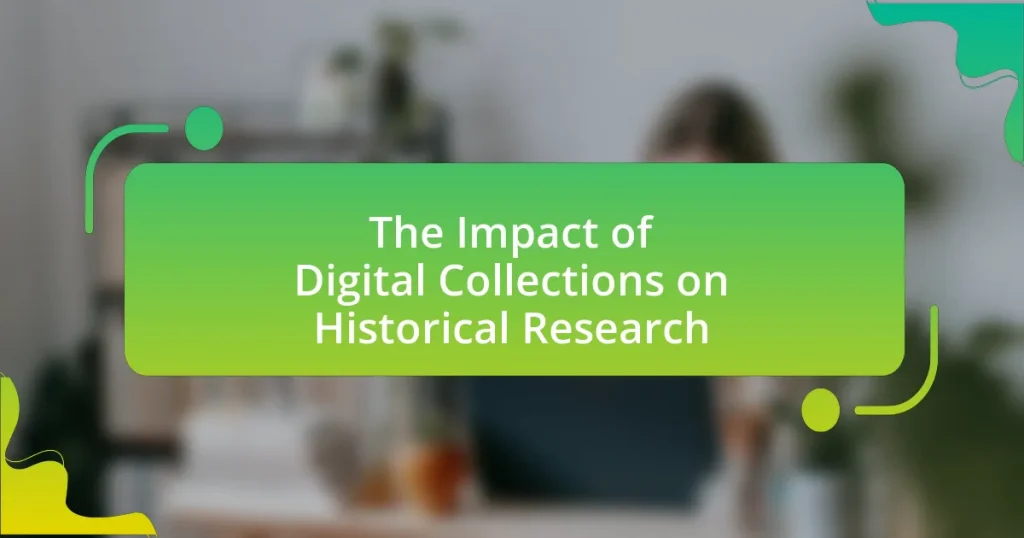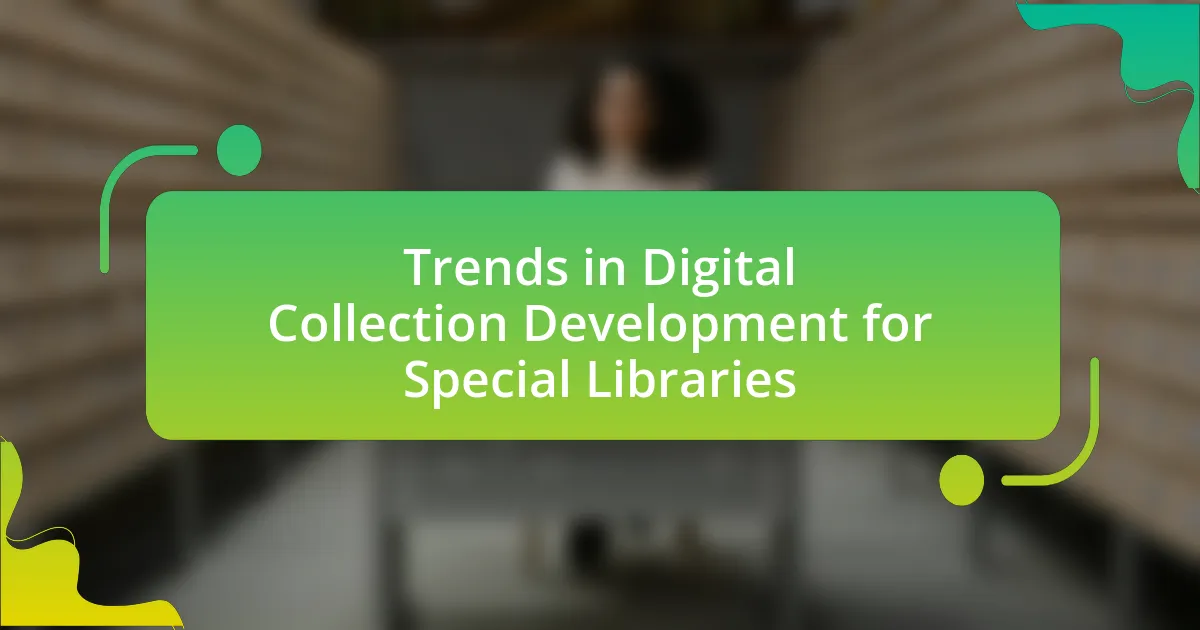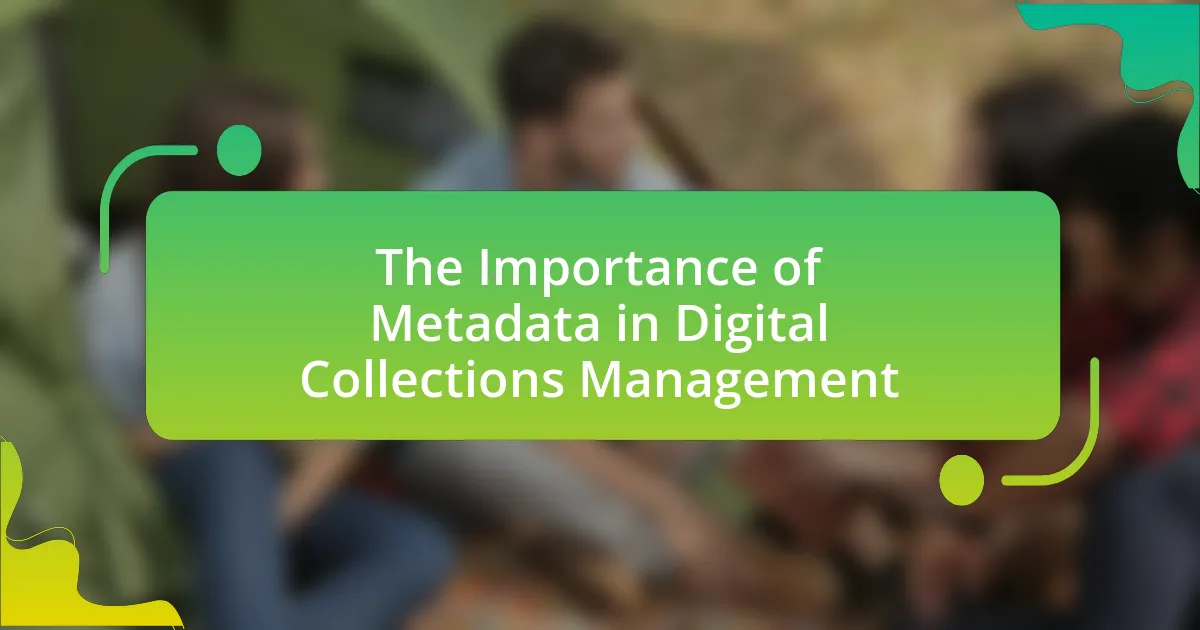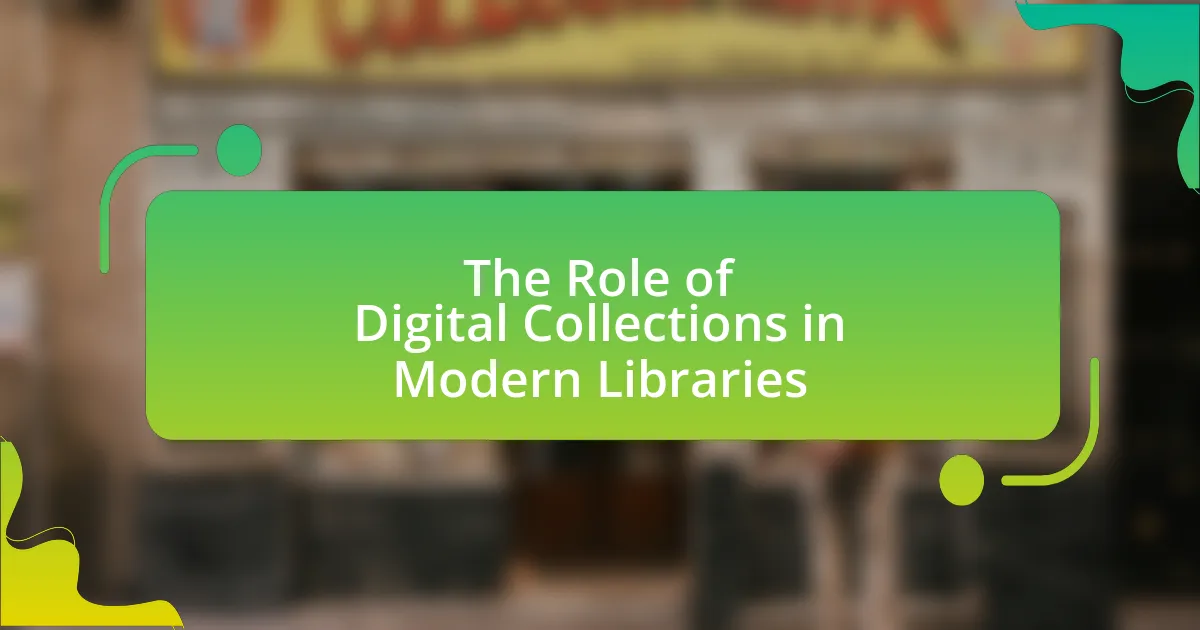Digital collections are curated groups of digitized materials, including documents, photographs, and artifacts, that enhance accessibility for historical research. They provide immediate access to primary sources, facilitating comprehensive analysis and collaboration among historians. The article explores the differences between digital collections and traditional archives, the technologies enabling their creation, and their impact on research efficiency and interpretation. It also addresses challenges such as data preservation, authenticity, and ethical considerations, while highlighting future trends like artificial intelligence and machine learning that will shape the landscape of historical research.
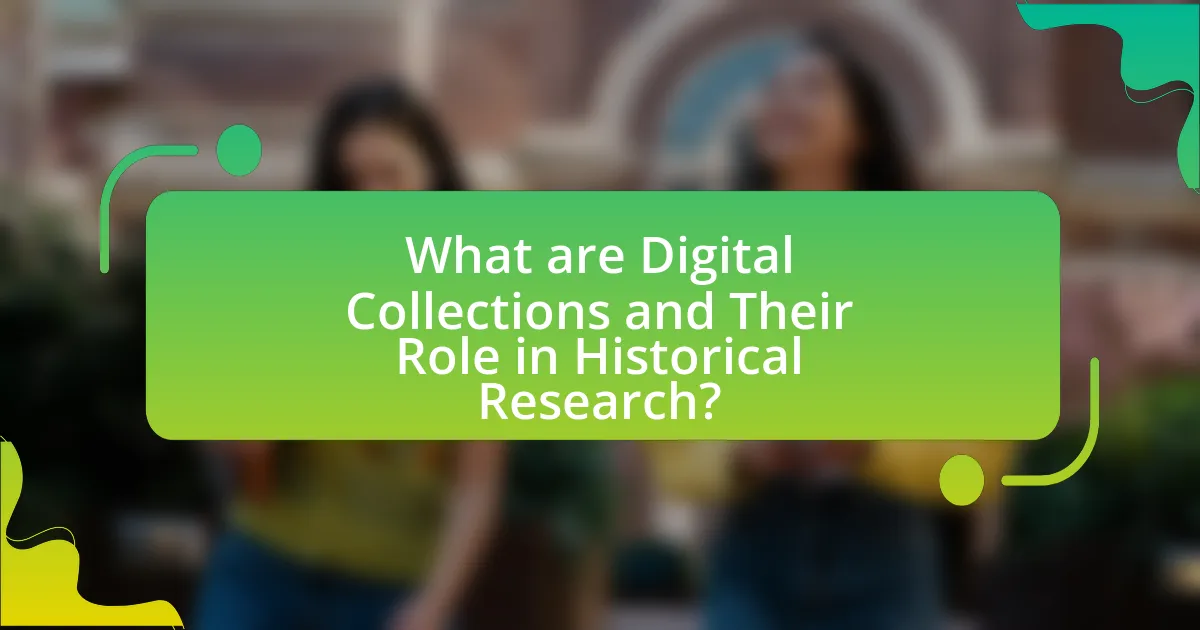
What are Digital Collections and Their Role in Historical Research?
Digital collections are curated groups of digitized materials, such as documents, photographs, and artifacts, that are made accessible online for research and educational purposes. Their role in historical research is significant, as they provide scholars with immediate access to primary sources that were previously difficult to obtain, thus facilitating a more comprehensive understanding of historical events. For instance, the Library of Congress offers a vast digital collection that includes historical newspapers and manuscripts, enabling researchers to analyze trends and narratives over time. This accessibility enhances the ability to conduct thorough investigations and fosters collaboration among historians globally.
How do digital collections differ from traditional archives?
Digital collections differ from traditional archives primarily in their format and accessibility. Digital collections are stored electronically, allowing for easier access and searchability, while traditional archives consist of physical documents that require on-site visits for consultation. For instance, digital collections can be accessed remotely via the internet, enabling users to explore vast amounts of information from anywhere, whereas traditional archives often have limited hours and require physical presence. This shift enhances research efficiency, as studies show that digital resources can significantly reduce the time needed to locate and analyze historical documents, thereby transforming the landscape of historical research.
What technologies enable the creation of digital collections?
Technologies that enable the creation of digital collections include digitization tools, content management systems, and metadata standards. Digitization tools, such as scanners and cameras, convert physical items into digital formats, allowing for preservation and accessibility. Content management systems, like Omeka and CONTENTdm, facilitate the organization, storage, and sharing of digital assets. Metadata standards, such as Dublin Core and MARC, provide structured information about the digital items, enhancing discoverability and interoperability across platforms. These technologies collectively support the effective creation and management of digital collections, which are essential for historical research.
How do digital collections enhance accessibility to historical materials?
Digital collections enhance accessibility to historical materials by providing online platforms where users can easily access, search, and interact with a vast array of documents, images, and artifacts. These collections eliminate geographical barriers, allowing individuals from diverse locations to engage with historical content that may otherwise be restricted to physical archives. For instance, the Library of Congress offers digitized collections that include over 14 million items, making it possible for researchers and the public to explore historical documents without needing to visit the library in person. This increased accessibility fosters greater public engagement and facilitates research by providing immediate access to primary sources, which is essential for historical analysis.
Why are digital collections important for historians?
Digital collections are important for historians because they provide unprecedented access to primary sources and archival materials. These collections enable historians to conduct research more efficiently by digitizing documents, photographs, and artifacts that were previously difficult to access due to geographical or physical constraints. For example, the Library of Congress and various university archives have digitized millions of documents, allowing historians to analyze a broader range of materials without the need for travel. This accessibility enhances the depth and breadth of historical research, facilitating new interpretations and insights into past events.
What unique opportunities do digital collections provide for research?
Digital collections provide unique opportunities for research by offering unprecedented access to a vast array of primary sources, which enhances the scope and depth of historical inquiry. Researchers can explore digitized manuscripts, photographs, and archival materials from various geographical locations and time periods, facilitating comparative studies and interdisciplinary approaches. For instance, the Digital Public Library of America hosts millions of digitized items, allowing scholars to analyze diverse perspectives on historical events. This accessibility not only democratizes research but also enables the use of advanced data analysis techniques, such as text mining and data visualization, to uncover patterns and insights that were previously difficult to identify in traditional collections.
How do digital collections facilitate collaboration among researchers?
Digital collections facilitate collaboration among researchers by providing a centralized platform for sharing and accessing diverse resources. These collections enable researchers to easily discover, share, and analyze data, fostering interdisciplinary collaboration. For instance, platforms like JSTOR and Project MUSE allow multiple researchers to access the same primary sources, enhancing collective analysis and discussion. Furthermore, digital collections often include tools for annotation and commenting, which promote real-time collaboration and feedback among researchers, thereby accelerating the research process and improving the quality of findings.
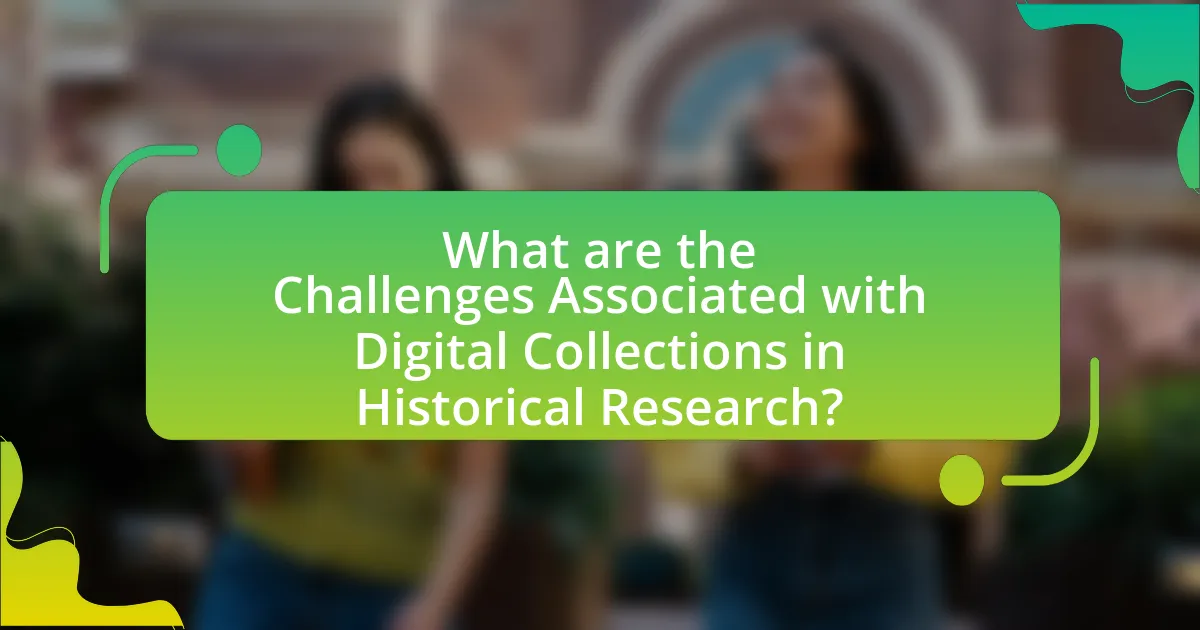
What are the Challenges Associated with Digital Collections in Historical Research?
Digital collections in historical research face several challenges, including issues of accessibility, data preservation, and the authenticity of sources. Accessibility can be hindered by technological barriers, such as the need for specific software or internet access, which can limit the reach of these collections. Data preservation is critical, as digital formats can become obsolete, risking the loss of valuable historical information; for instance, a study by the Digital Preservation Coalition highlights that 90% of digital data is at risk of being lost within a decade. Furthermore, the authenticity of sources can be questioned due to the ease of manipulation in digital formats, making it difficult for researchers to verify the credibility of the materials. These challenges complicate the effective use of digital collections in historical research.
What issues arise regarding the preservation of digital collections?
The preservation of digital collections faces several significant issues, including technological obsolescence, data degradation, and access challenges. Technological obsolescence occurs as software and hardware evolve, rendering older formats and storage media inaccessible; for instance, many digital files created in the early 2000s are now difficult to retrieve due to outdated software. Data degradation refers to the deterioration of digital files over time, which can lead to loss of information if not regularly migrated to current formats. Access challenges arise from the need for specialized knowledge and resources to maintain and retrieve digital collections, which can limit their usability for researchers. These issues highlight the complexities involved in ensuring the longevity and accessibility of digital collections for historical research.
How does digital obsolescence affect historical research?
Digital obsolescence significantly hinders historical research by rendering digital materials inaccessible over time. As technology evolves, formats and platforms used to store and present historical data may become outdated, leading to loss of information. For instance, many digital archives created in the early 2000s are now difficult to access due to obsolete file formats or software incompatibility, which can result in gaps in historical records. This phenomenon is evidenced by the decline of certain digital platforms, such as Adobe Flash, which was widely used for multimedia content but is no longer supported, causing loss of access to numerous historical resources. Consequently, researchers face challenges in retrieving and analyzing digital artifacts, which can impede the comprehensive understanding of historical narratives.
What are the ethical considerations in digitizing historical materials?
Ethical considerations in digitizing historical materials include issues of copyright, consent, cultural sensitivity, and the potential for misrepresentation. Copyright laws protect the rights of creators and their descendants, necessitating careful evaluation of ownership before digitization. Consent is crucial, particularly for materials related to marginalized communities, ensuring that their voices and perspectives are respected. Cultural sensitivity involves recognizing the significance of certain materials to specific groups and avoiding exploitation or appropriation. Misrepresentation can occur if digitized materials are taken out of context or presented in a misleading manner, which can distort historical narratives. These considerations are essential to maintain integrity and respect in the preservation and dissemination of historical knowledge.
How do digital collections impact the interpretation of historical data?
Digital collections significantly enhance the interpretation of historical data by providing broader access to primary sources and facilitating comparative analysis. These collections allow researchers to examine a diverse array of documents, images, and artifacts that were previously difficult to access due to geographical or financial constraints. For instance, the Digital Public Library of America offers millions of digitized items from libraries, archives, and museums across the United States, enabling scholars to analyze historical narratives from multiple perspectives. This increased accessibility not only democratizes historical research but also encourages interdisciplinary approaches, as seen in studies that integrate digital humanities methods to analyze large datasets. Consequently, digital collections reshape our understanding of history by revealing previously overlooked connections and contexts, thereby enriching the overall interpretation of historical data.
What biases might be introduced through digital curation?
Digital curation can introduce biases such as selection bias, confirmation bias, and contextual bias. Selection bias occurs when curators choose specific items for inclusion, potentially omitting significant artifacts that represent diverse perspectives. Confirmation bias arises when curators favor materials that support pre-existing narratives or viewpoints, leading to a skewed representation of history. Contextual bias is introduced when the presentation of curated items lacks sufficient context, which can mislead users about their significance or relevance. These biases can distort historical understanding and affect research outcomes, as evidenced by studies showing that curated collections often reflect the values and priorities of those who create them, rather than a comprehensive view of history.
How can researchers mitigate these biases in their work?
Researchers can mitigate biases in their work by employing diverse data sources and implementing rigorous peer review processes. Utilizing a variety of digital collections ensures a broader representation of historical narratives, which helps counteract the limitations of singular perspectives. For instance, studies have shown that incorporating multiple archives can reveal underrepresented voices and provide a more nuanced understanding of historical events. Additionally, engaging in peer review allows for critical evaluation of methodologies and interpretations, fostering accountability and reducing individual biases. Research indicates that collaborative efforts among historians can lead to more balanced conclusions, as seen in projects like the Digital Public Library of America, which emphasizes inclusivity in historical documentation.

What Future Trends Can We Expect in Digital Collections for Historical Research?
Future trends in digital collections for historical research include increased use of artificial intelligence for data analysis, enhanced accessibility through cloud-based platforms, and the integration of immersive technologies like virtual reality. Artificial intelligence will enable researchers to analyze vast datasets more efficiently, identifying patterns and connections that were previously difficult to discern. Cloud-based platforms will facilitate greater collaboration among historians and institutions, allowing for real-time sharing and updating of resources. Additionally, immersive technologies will provide new ways to engage with historical materials, offering interactive experiences that can enhance understanding and retention of historical knowledge. These trends are supported by ongoing advancements in technology and the growing demand for innovative research methodologies in the field of history.
How is artificial intelligence shaping the future of digital collections?
Artificial intelligence is transforming the future of digital collections by enhancing data organization, improving accessibility, and enabling advanced analysis. AI algorithms can automate the categorization and tagging of vast amounts of digital content, making it easier for researchers to locate specific materials. For instance, machine learning techniques can analyze historical texts and images, identifying patterns and connections that may not be immediately apparent to human researchers. This capability not only streamlines the research process but also uncovers new insights, as demonstrated by projects like the Digital Public Library of America, which utilizes AI to enhance user experience and content discoverability.
What role does machine learning play in analyzing historical data?
Machine learning plays a crucial role in analyzing historical data by enabling the extraction of patterns and insights from large datasets that would be impractical to analyze manually. This technology applies algorithms to identify trends, correlations, and anomalies within historical records, enhancing researchers’ ability to interpret complex information. For instance, machine learning techniques such as natural language processing can analyze vast amounts of text from historical documents, allowing for the identification of themes and sentiments over time. Additionally, predictive modeling can forecast future trends based on historical data, providing valuable context for understanding past events. The effectiveness of machine learning in this domain is supported by studies demonstrating its ability to improve accuracy and efficiency in data analysis, such as the use of machine learning in digitized archives to uncover previously unnoticed relationships among historical entities.
How can AI improve user engagement with digital collections?
AI can improve user engagement with digital collections by personalizing content recommendations based on user behavior and preferences. By analyzing user interactions, AI algorithms can identify patterns and suggest relevant items, enhancing the discovery process. For instance, a study by the Pew Research Center found that personalized recommendations can increase user engagement by up to 70%, as users are more likely to explore content that aligns with their interests. Additionally, AI-driven chatbots can provide instant assistance, answering queries and guiding users through collections, further increasing interaction and satisfaction.
What best practices should researchers follow when utilizing digital collections?
Researchers should follow best practices such as ensuring proper citation, verifying the authenticity of digital collections, and utilizing advanced search techniques. Proper citation is crucial for maintaining academic integrity and allows others to trace the sources used in research. Verifying authenticity involves cross-referencing digital collections with established databases or original sources to confirm their reliability. Advanced search techniques, including the use of specific keywords and filters, enhance the efficiency of locating relevant materials within vast digital archives. These practices are supported by guidelines from institutions like the American Historical Association, which emphasizes the importance of rigorous standards in historical research.
How can historians ensure the credibility of digital sources?
Historians can ensure the credibility of digital sources by critically evaluating the origin, authorship, and context of the information presented. They should verify the credentials of the authors, assess the reliability of the hosting platform, and cross-reference the digital content with established scholarly works. For instance, a study published in the “Journal of Digital Humanities” emphasizes the importance of source verification, stating that 70% of digital sources lack proper citations, which can mislead researchers. By applying these rigorous evaluation methods, historians can discern credible digital sources from unreliable ones.
What strategies can enhance the effectiveness of research using digital collections?
Utilizing advanced search techniques significantly enhances the effectiveness of research using digital collections. Researchers can employ Boolean operators, proximity searches, and filters to refine their queries, leading to more relevant results. For instance, a study by the Digital Library Federation highlights that using specific keywords combined with Boolean operators can increase the retrieval of pertinent documents by up to 40%. Additionally, leveraging metadata and tagging systems within digital collections allows researchers to discover related materials that may not appear in standard search results, further enriching their research outcomes.
